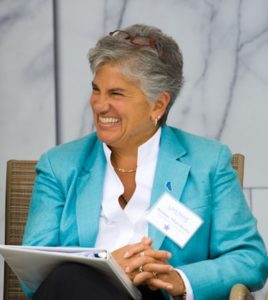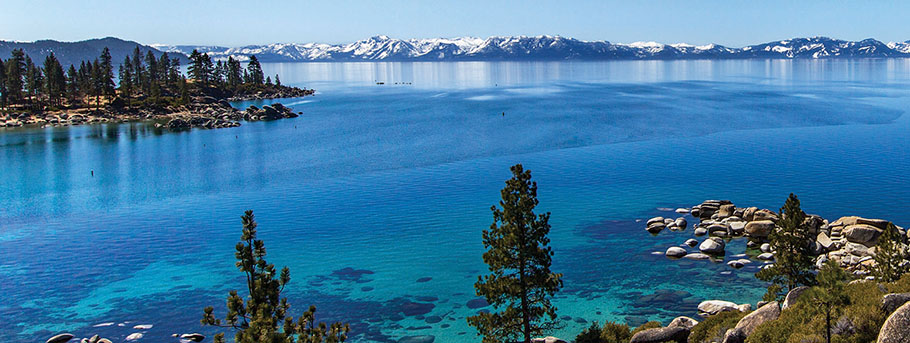By Joanne S. Marchetta

Over the past decade and a half working to protect and restore Lake Tahoe, I’ve learned many lessons. The first is that being paralyzed by our differences has dire consequences for the lake and our communities. Doing nothing is not an option. The second and most important lesson is that achieving anything requires each of us to find common ground, get over our turf, and work toward shared goals. Sounds simple, but in today’s fractured world, working to find common ground takes special work and the work is never done.
When I stepped in as Executive Director of the Tahoe Regional Planning Agency (TRPA) in 2009, the Tahoe Basin was badly fractured. I had been the agency’s general counsel for four years, so I knew what was ahead. And I also knew that if TRPA could shift its culture from a top-down, regulatory mindset to one of collaboration and partnership, we could more readily overcome Tahoe’s most intractable problems and achieve some truly ambitious environmental goals.
It was a return to TRPA’s roots. Nevada and California created TRPA more than 50 years ago through a ground-breaking partnership that established the first landscape-scale planning agency in the nation for the protection and restoration of an ecosystem. By bridging the invisible boundaries of two states and six local governments, TRPA was literally born of a partnership. That means TRPA’s first job is to find common ground and cooperation. However, to rein in rampant overdevelopment, the agency quickly strayed from the partnership way.
The creation in 1997 of the Lake Tahoe Environmental Improvement Program, or EIP, reestablished collaboration as the model for progress in the Tahoe Basin. Over the last 25 years, the collaboration of the EIP has brought more than $2.6 billion in investment to Tahoe for 760 restoration projects including stormwater infrastructure, bike trails, and nearly 90,000 acres of forest health projects. Today it is an epic collaboration of nearly 100 organizations working to restore Tahoe’s harmed ecosystem.
Under the EIP, we’ve built up the nation’s leading watercraft inspection program and halted the spread of new aquatic invasive species in the region. When asked by leaders in Washington D.C. and elsewhere how the program has managed to protect a 190-square mile lake that sees about 15,000 boat launches a year, we tell the story of epic collaboration. Boaters and many partners came with TRPA out of our silos and went forward together to protect what we had in common—the lake itself.
The 2012 Regional Plan Update brought a collaborative model to TRPA’s permitting and regulatory role. The update helped shift TRPA’s culture and focus from stopping bad development to supporting projects that bring about environmental improvements. Today, property owners have access to incentives and streamlined permit processes, and local governments have more control through area plans.
Following the 2007 Angora Fire, TRPA helped form the Tahoe Fire and Fuels Team and in partnership with forest and fire managers, we have streamlined tree removal on private properties and updated multiple policies to speed forest fuel reduction projects. Some of which may just have saved us during the Caldor fire last year.
All this collaboration is working. In the most recent review of TRPA’s environmental standards, 79 percent of the standards evaluated are in attainment and 96 percent are stable or improving.
This is important because, at the end of this month, I am stepping down from my position at TRPA. After 17 years, my life is turning a corner and it is time for me to let the story of epic collaboration be continued by you. It has been an honor and a privilege to serve the region in this capacity and I hope that you keep working together to find more common ground, build more trust, fix broken relationships, set new shared goals, and maintain the positive progress.
While we’ve come a long way, big challenges are in front of us. Tahoe needs collaborative leadership to continue to find solutions in transportation, workforce housing, climate adaptation, forest resilience, destination stewardship, and lake clarity initiatives. Rather than falling back into our silos of us versus them, we need to roll up our sleeves and move beyond the hardened positions of my way, to our way, the partnership way. With Tahoe’s future in the balance, the cost of doing nothing is too great. What I wish most for Tahoe is that you find in your hearts the resolve to carry on this legacy of epic collaboration. Be well and stay connected.
–Joanne S. Marchetta is the Executive Director of the Tahoe Regional Planning Agency through June 30, 2022.

